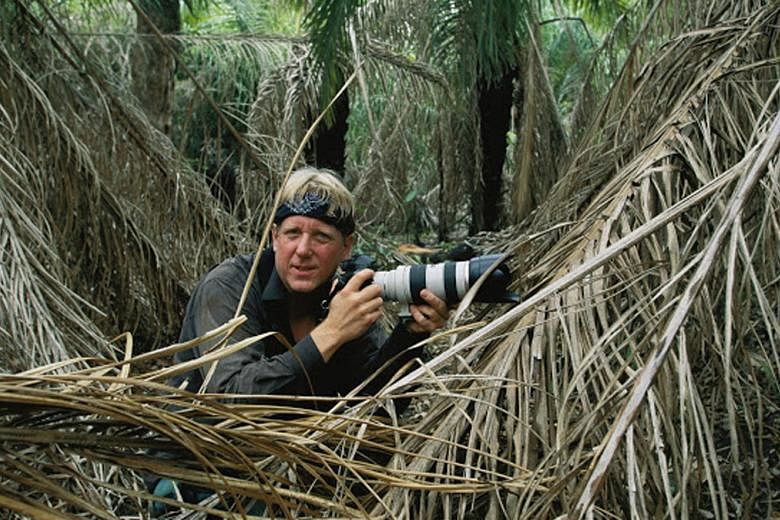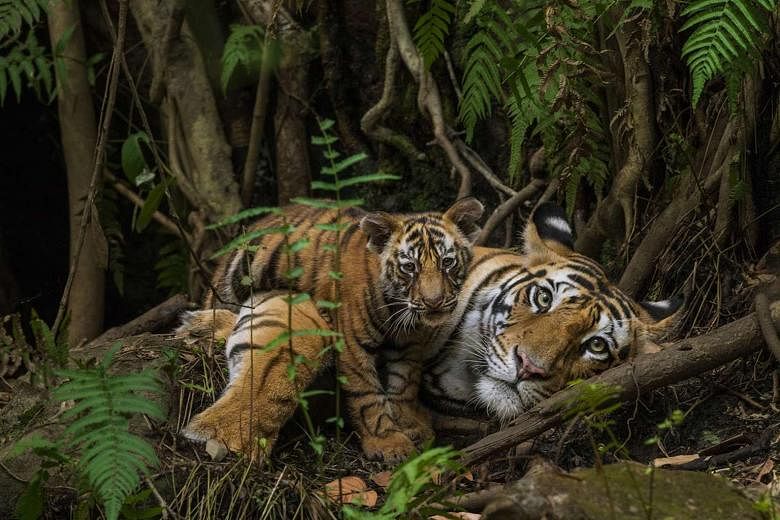Want to win free tickets to My Nine Lives? Details here: .pdf
Acclaimed National Geographic wildlife photographer and conservationist Steve Winter did not snap pictures of animals until he was 34. In fact, he was not an animal guy when he was young.
Instead, he was a "hardcore photojournalist" who covered political and economic subjects for publications such as Time, Newsweek and BusinessWeek, even photographing then United States President Bill Clinton at the White House.
"Animals happened by accident," he tells Life in a phone interview from a tent in Sri Lanka, where he was on a job out in the woods.
In 1992, he took an assignment to do a public relations shoot for Merck Pharmaceuticals, whose scientists were trying to find new drugs in the Costa Rican rainforest.
"We had two days between our main programme and they asked if I wanted to photograph arribada, which is a Spanish term for marine turtles nesting on the beach. When I came back, I showed the images to National Geographic. That started the whole career," he recalls.

-
BOOK IT/MY NINE LIVES WITH STEVE WINTER
-
Where: Esplanade Concert Hall
When: Aug 25, 7.30pm
Admission: $39 to $69 from Sistic. National Geographic is offering The Straits Times readers 15 per cent off ticket prices. Book with Sistic with the password "sponngl" at http://bit.ly/natgeoST
Info: www.nglive.org/singapore
The 59-year-old will be in Singapore on Aug 25 for the ticketed programme My Nine Lives With Steve Winter, which is part of the National Geographic Live Singapore series, now in its second year. The event, where he will share gripping tales such as coming face-to-face with tigers in India's Kaziranga National Park, is described as "visual storytelling".
His career change has been fruitful. Winter, who is married with one son, is now a highly respected figure in the field.
He has been named BBC Wildlife Photographer of the Year (2008) and BBC Wildlife Photojournalist of the Year (2012), and is a two-time winner of the Picture of the Year International "Global Vision Award" (2011 and 2012) and the World Press Photo prize (nature category).
His famous images of the highly elusive cougars of downtown Los Angeles are campaign materials for a project to build the world's largest wildlife safe-crossing over Santa Monica's 101 Freeway, where many mountain lions have been hit by oncoming traffic.
By using innovative "camera trap" technology, he managed to photograph a large male cougar standing in front of the iconic Hollywood sign on Mount Lee.
1 How did you get into photography?
I left art school and did fashion photography for Macy's department store only because it was the first job I was offered. When you get out of school and somebody offers you a job, you take it.
2 Where did you get the idea to do live shows?
I try to tell animals' stories so I can help save them. Though a live show may not reach that many people, it's a more intimate experience. You can reach people in a personal way.
When my images are in the pages of National Geographic, on the Web or on iPads, I don't know how people feel when they look at them. But when the audience is in front of me, I can see how they're reacting.
3 Was there a time when you thought you wouldn't make it home alive?
Probably when I was working in northern India's Kaziranga National Park, which had rhinos that were very sensitive to me, my driver and anti-poaching patrols. I was on top of an elephant when one of the rhinos attacked. We were chased for about 500m - I thought I was going to die.
4 What's the most extreme thing you've done to get a good photo?
I almost died trying to get a photograph of that rhino chasing us. It jumped up on its hind legs and tried to attack the guard on the elephant. When the rhino bit the elephant on its hind leg, the elephant jerked to the right and I nearly flew off.
You're scared, but you still take pictures because that's a situation you have to cover as a photographer for National Geographic.
5 Fieldwork can be exhausting. How do you relax on the job?
I don't. We do 16-hour days and work to the point of exhaustion. You're lucky if you get five hours of sleep a night.
I drink a lot of coffee - it's the only way I can keep going.
6 Do you photograph your pets at home?
I love dogs. Out in the jungle, I work with big cats, but at home, I'm a dog guy. My iPad and iPhone screensavers are of my dog, Lily. I always pick up strays or my wife does.
7 What are your thoughts on selfies?
As a photographer, I'm extremely happy that we all carry cameraphones in our pockets. We all become so much more visually literate as a result. I have a GoPro stick and record video selfies all the time, so I have to like selfies.
8 How would you like to be remembered?
As someone who did his best to help save big cats and their homes. The forest provides 50 per cent of the oxygen we breathe and 75 per cent of the freshwater we drink. If we save the big cats and where they live, then we can help save ourselves.


